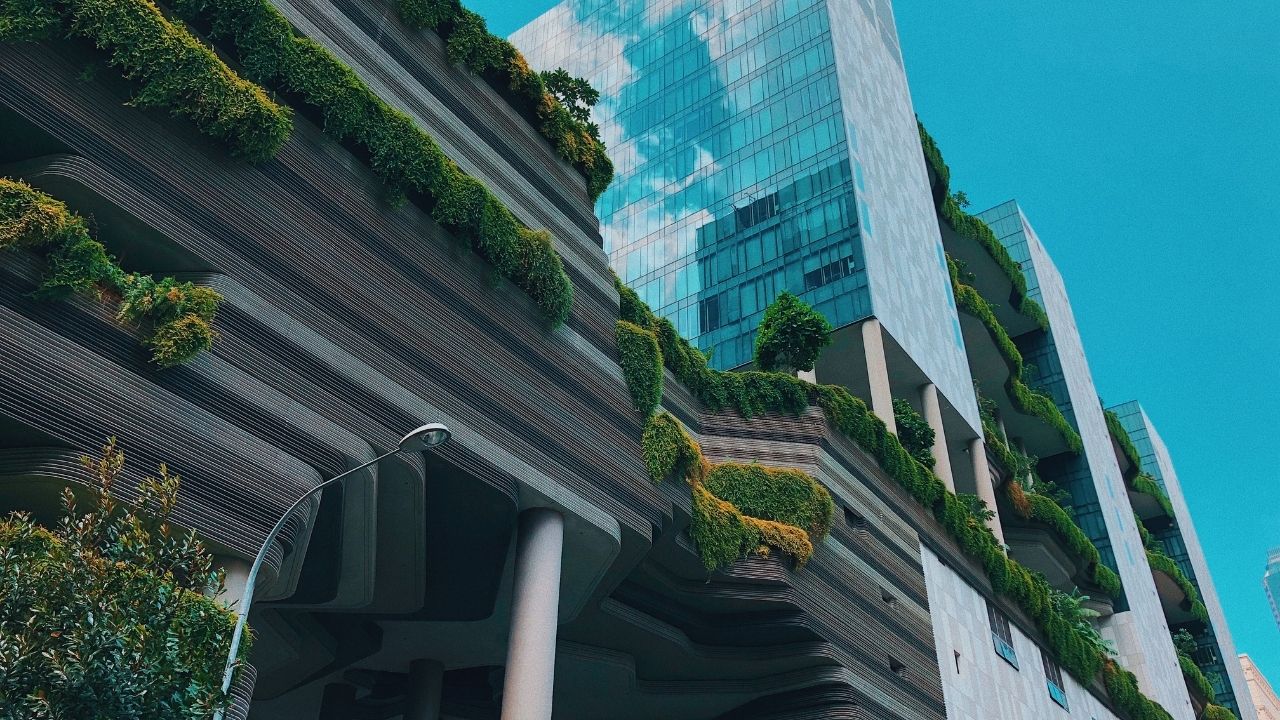- The average green building is worth 7% more than its traditional counterpart.
- Integrating green principles into a building’s planning and design process can generate 40% more savings and 40% better performance than simply adding green technologies to a traditionally planned and designed facility.
- Green buildings’ design criteria raise morale and employee satisfaction, which also improves productivity.
Real estate is responsible for 40% of the world’s carbon emissions. This is a depressing statistic, but it can be lowered if humanity puts in the effort.
Green buildings have less negative impact on the environment than standard buildings. Their construction minimizes on-site grading, saves natural resources by using alternative building materials, and recycles construction waste rather than sending it to landfills.
A majority of a green building’s interior spaces have natural lighting and outdoor views, while highly efficient HVAC (heating, ventilating, and air-conditioning) systems and low-VOC (volatile organic compound) materials like paint, flooring, and furniture create a superior indoor air quality.
It is no longer true that sustainable buildings have to be more expensive.
- The average green building is worth 7% more than its traditional counterpart
- Green buildings are 14% less costly to operate than traditional buildings
- Market demand for green buildings is doubling every three years
A green and sustainable building/work model is less expensive than regular models
Hundreds of U.S. and international studies have proven the financial advantages of going green.
Well-designed green buildings have lower utility costs. In its first year of operation, Genzyme Center used 42% less energy and 34% less water than standard buildings of comparable size. The Genzyme Center also recycled over 90% of the project’s construction waste.
Besides being cheaper to run, green buildings’ design criteria—including abundant daylighting, individual climate controls, and outdoor views—raise morale and employee satisfaction, which also improves productivity.
Green building materials, mechanical systems, and furnishings have become more widely available, and their prices have dropped considerably, and in some cases even below the cost of their standard counterparts.
Studies of more than 150 sustainable buildings across the U.S. show that on average it costs only 0.8% more to achieve basic LEED certification than to construct a standard building.
The PNC Firstside Center was already under construction as a standard building when the owner decided to go green instead. The project was completed two months early, came in $4 million under the original construction budget, and earned LEED’s Silver rating, according to the Harvard Business Review.
Now, PNC has constructed more than 200 planned green bank branches. The average construction time was 45 days faster than for PNC’s traditional branches, and the costs were the same or lower. In the northeastern part of the country, PNC’s green branches each came in $100,000 below the cost of a competitor’s new standard branches.
The LEED-Platinum CII-Sohrabji Godrej Green Business Centre in Hyderabad, India (the greenest building in the world when it was completed in 2003) was given a circular design that brings sunlight to every part of the 20,000-square-foot building.
During the day, artificial lighting is not used in 90% of the Green Business Centre. Thanks to its green design and energy efficient technologies, it uses 55% less energy than a standard building of similar size.
According to William Browning, a senior fellow at the Rocky Mountain Institute in Colorado, integrating green principles into a building’s planning and design process can generate 40% more savings and 40% better performance than simply adding green technologies to a traditionally planned and designed facility.
There are incentives for green buildings
Green technologies may cost more up front than standard building systems, but companies and developers can stay on budget by taking advantage of the growing number of incentives and funding opportunities offered to companies installing building systems that save energy over the long run.
For example, the city of Charlottesville in Virginia has several incentives for efficient buildings. Commercial and residential buildings that meet energy efficiency standards are eligible for a reduced tax rate of 50% on the building value for one year.
Businesses in Charlottesville can receive funding from the Clean Energy Commercial Loan Program to invest in energy efficiency improvements. Through LEAP, Charlottesville also funds the limited time 0% Power Saving Loan Program to buy down Power Savings Loans to a 0% interest rate over a five-year term.
Creating green workplaces and buildings is important for a sustainable future
As investors and occupiers become more knowledgeable about and concerned with the environmental and social impacts of the built environment, buildings with better sustainability credentials will have increased marketability.
Quite a few coworking spaces have gone green. Huckletree in London is designed in a sustainable and eco-friendly way, utilizing recycled materials for flooring and furniture. Members also observe a strict waste management policy.
Consumers tend to choose products and services that they know are eco-friendly, which boosts profit and reputation.
Sustainable design is more achievable than ever and no longer has to be more expensive to deliver.
As green goes mainstream, standard buildings will rapidly become obsolete and lose value. To avoid this problem, building owners should carry out green renovations.


 Dr. Gleb Tsipursky – The Office Whisperer
Dr. Gleb Tsipursky – The Office Whisperer Nirit Cohen – WorkFutures
Nirit Cohen – WorkFutures Angela Howard – Culture Expert
Angela Howard – Culture Expert Drew Jones – Design & Innovation
Drew Jones – Design & Innovation Jonathan Price – CRE & Flex Expert
Jonathan Price – CRE & Flex Expert













